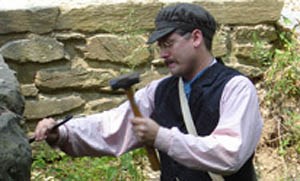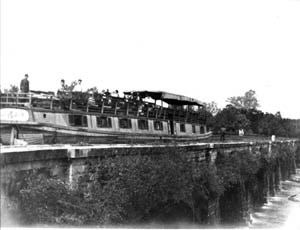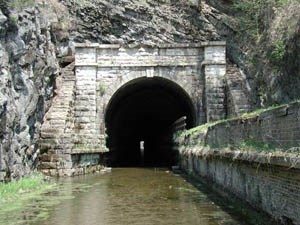Last updated: March 5, 2024
Article
The Workers Who Built the C&O Canal

NPS.
The Chesapeake and Ohio (C&O) Canal is one of the most intact and impressive surviving examples of the American canal-building era. Construction of the C&O Canal began on July 4, 1828. By the time of its completion in 1850, the canal stretched 185 miles from Washington, D.C. to Cumberland, Maryland. From 1831 to 1924, the canal primarily served as a means to transport coal from the Allegheny Mountains to ships waiting in port cities. Mail travelling between Georgetown, the District of Columbia, and Shepherdstown, West Virginia, was also transported along a portion of the canal. The historical importance of the canal was the basis for creation of the Chesapeake and Ohio Canal Historical Park, established in 1961 through the efforts of Supreme Court Justice William O. Douglas.
The untold stories of the lives of the workers that constructed the canal have the potential to add another dimension to the C&O Canal’s historical significance. The majority of the laborers on the canal were Irish immigrants, with a few Germans and native-born Americans. Early on, enslaved blacks were used in some places, but that practice had largely been abandoned by the time construction reached the Blue Ridge, near present-day Hagerstown, Maryland. Over a 22-year period, workers labored in difficult and often dangerous conditions to construct a safe transport system between the coal producing Allegany Mountains in the west and the port cities and industrial centers in the east.
Canaller Culture
The C&O Canal Company relied on the wage labor force to construct the canal at a low cost to investors. In this equation, the laborers were an expense to be minimized; the less they were paid, the more the investors made. Skilled tradesmen, carpenters, and stonemasons were needed for the locks, aqueducts, and culverts. The back-breaking work of digging the canal prism, however, was accomplished by the lowest-paid laborers using the simplest of tools—shovels, picks, and wheelbarrows.
Work along the line of the C&O Canal was difficult. Laborers worked 12 to 15 hour days in all kinds of weather, beginning at sunup and continuing to sundown. The workers would spend much of their day in the ditches, mired in mud or water up to the waist. Injuries were common on the line, and maiming and death far from rare.
At the end of the day, the canallers returned home to small houses and primitive living conditions. Laborers lived in makeshift shanties at the worksite, often in a bunk house with 15 to 20 other men. In some cases, married men constructed huts for their families who traveled with them along the canal line. The women living in these shanty towns were not employees of the company; however, by managing the domestic life of the camp, they served the needs of the industry. Women were as much a part of canaller culture as the men working in the ditches.
Poor living conditions often led to hunger and sickness among the canal workers, and serious illness was a very real threat. Epidemics regularly swept the line, separating men from their families and leaving a trail of bodies in their wake. The 1832 cholera epidemic left many dead and caused others to flee to relative safety elsewhere.
The canallers accepted certain risks as inherent in the job of creating a waterway transport system. To ease tensions created by working strenuous jobs in difficult conditions, canallers often resorted to violence and threatened others in the ditches. In the six years between 1834 and 1840, the C&O Canal Company experienced at least ten significant disturbances, and virtually continuous labor unrest. Ethnic groups often banded together against one another (for example, German versus Irish) and expressed their anger at the working and living conditions by fighting with each other.
The most grievous incident of labor unrest occurred in August 1839, when rumors of future labor reductions spread through the trenches. Irish laborers feared for their jobs and sought to make their own reductions in the canal work force rather than wait for the Company to make a decision. On August 11, about 100 armed Irish workers from the Paw Paw Tunnel, bordering Maryland and West Virginia, marched on German laborers downriver near Little Orleans, Maryland. The details of the event were reported in the newspaper, The Daily National Intelligencer
The violence carried out that day caused a priest, Father Guth, who ministered to the German laborers, to confess in a letter to the Chief Engineer of the C&O Canal, “...were I superstitious I would really believe they [the Irish rioters] are incarnate Devils.”
Despite numerous acts of protest and violence, working and living conditions for the canal workers did not improve. After the events of August 1839, the Washington and Allegany County militias swept the work line. Over two dozen leaders from Irish gangs were arrested and prosecuted; many others were banned from the canal.
Labor unrest lessened after the incident but never completely disappeared. Severe financial problems forced the company to cut back on construction labor. Unemployed laborers straggled off the line to find work elsewhere. Many canallers found other sorts of jobs, moving to the mines, docks or, eventually, railroads. Because of increasing debts, and the completion of the Baltimore and Ohio Railroad which rendered waterway transport obsolete, construction ended 180 miles short of the original goal to reach the Ohio Valley.
Investigations at the Canal: Locating Worker Campsites
In 2011, The Louis Berger Group, a cultural resource archeology firm, completed a nine-year archeological survey of the C&O Canal on behalf of NPS. The primary goal of this project was to locate canal worker campsites to provide a more complete narrative of the various peoples who built the canal.
The construction of facilities such as dams, aqueducts, and the Paw Paw Tunnel employed hundreds of workers for many months. Archeologists expected these large concentrations of people to leave archeological signatures. However, it proved challenging to separate a canal-worker signature from the general distribution of historic artifacts along the canal. Prior to the 2011 survey, no known archeological sites along the canal were attributed to the workers who constructed the waterway. Efforts to identify the locations of canal workers’ camps began with a review of the numerous previously recorded sites along the canal.

NPS.
Monocacy Site
One such site was on the west bank of the Monocacy River, in Frederick, Maryland, adjacent to the canal’s aqueduct. The largest of 11 C&O canal aqueducts was built across the Monocacy River, a large tributary of the Potomac River. The Monocacy site was excavated in the early 1970s by students from Catholic University in Washington D.C. They identified a substantial prehistoric settlement at the confluence of the Monocacy and Potomac Rivers. Since the students’ focus during that project was the prehistoric component, little attention was paid to the numerous historic artifacts recovered from the upper strata at the site.
Objects in the collection included cut nails, bottle glass, fragments of white clay tobacco pipes, and sherds of earthenware dishes. These materials probably date to the first half of the 1800s. The site could have been a warehouse of some kind, or an outlying barn. Another possibility is that these cultural remains are the remnants of a canal workers’ camp. Nails, bottle glass, and tobacco pipes are exactly what archeologists would expect from a workers’ “shanty town.”
Chick Farm Site
Another site that may represent the remains of a workers’ camp was found just up river from the Monocacy site at the Chick Farm in Frederick, Maryland. A reassessment of William Barse’s excavation at Chick Farm raised the possibility that a canal workers’ camp was located here. An assemblage of ceramic sherds was found in the soil layer dating to 1825. Further analysis showed that ceramic artifact density rapidly decreased over the next ten years. The dates correspond to the period of canal construction near the Monocacy River. Construction and woodworking tools were also recovered from the site. They included gouges, a chisel, augers a shovel fragment and broken picks. It is possible that area residents supplemented their farming with woodworking; however, it is more likely that canal work crews used the area as a work yard in the 1830s.
Methods of Campsite Identification
The possibility of the Chick Farm and Monocacy sites being canal workers’ camps led archeologists to refine their methods for identifying additional locations where workers lived and worked. Archeologists continued to test locations where major canal projects occurred, and to conduct a search of relevant documentary records. These included maps, newspaper accounts, and diaries as well as the extensive collection of C&O Canal Company records.
After searching through land history records, several other possible workers’ camps were identified. One document contained within the C&O Canal Company records was an 1835 letter from the master of the Antietam Iron Furnace, in Antietam, Maryland, to the president of the C&O Canal Company complaining of the workers living nearby. The company president responded that he would move the workers as soon as the weather warmed, suggesting that the camp was in place over an entire winter.
Archeologists searched for the winter shanties at the mouth of Antietam Creek. Excavation and metal detection were difficult to complete because the area was covered with a dense deposit of slag from the iron workers at the Antietam furnace, in Antietam, Maryland. The slag probably dates to a time after the furnace switched from charcoal to coke, a low-smoke emission alternative to coal that can withstand higher temperatures, in the 1860s. If so, the slag deposit may have capped and preserved the location of the shanties.
Archeologists excavated shovel test pits in the C&O Historical Park area, and a handful of historic artifacts was recovered from underneath the slag: a plain brass button, machine-cut nails, other types of nails, an iron staple, unidentified pieces of iron, a sherd of whiteware (post-1820), and a decorated pipestem. Although not conclusive, these artifacts could come from a canal workers’ camp. Alternatively, the artifacts may have been discarded by workers at the iron works, whose trash might have ended up mixed with the slag.

NPS.
Paw Paw Tunnel
Other documents within the C&O Canal Company records refer to the workers’ camp and company office at the Paw Paw Tunnel. The tunnel was constructed to bypass a part of the Potomac River that meanders 5 times in 6 miles. It was lined on the inside with 7 to 11 layers of bricks, approximately 5 million bricks in all.
A common method of brick-making in the early nineteenth century consisted of firing stacks, called clamps of dried, unfired bricks. After bricks were molded from clay and binding materials and dried in the sun, they were added clamps for firing. The clamps were constructed on a level ground surface or platform. The unfired bricks were stacked in several parallel rows about three bricks thick, leaving gaps for air to pass through. Fuel, usually wood, was placed in the flues, or alleys, between the rows. After the height of each row had reached about two feet, arches of brick, creating tunnels, connected the rows. A rectangular structure of brick was built over the arches. The exterior of the clamp consisted of bricks stacked closely together to maintain the necessary heat within the clamp.
Initially the C&O Canal Company intended to fire the bricks for the Paw Paw Tunnel, using local materials with clamps constructed at the work site. Eventually, the bricks were found to be of poor quality and not be suitable for use. The company records do not indicate what happened to the brickworks but it is likely the bricks and clamps were abandoned in place.
Between 2008 and 2010, archeologists excavated a site near the Paw Paw Tunnel and identified three features. Two of the features were carefully laid brick platforms located approximately 2 feet below ground surface. A linear layer of thick ash and charcoal lay over part of one of the platforms. The deposit measured approximately 2 feet wide and extended the length of the platform. The coal and ash deposit possibly represent the flues of workers’ brick clamps. The coal and ash deposit identified on the clamp at the site may represent the last time the Paw Paw Tunnel workers fired clamps before they abandoned the brickworks in 1838.
Excavations also revealed the substantial remains of the canal company office and store. The foundation consisted of three courses of carefully laid brick, surmounted by a two layers of flat, roughly shaped stone. Additional testing showed that the wall measured 70 feet in length, running in an east-to-west direction. Limited excavation around both ends did not produce any evidence of the perpendicular walls. The existing wall suggests the structure was quite large.
The only artifacts recovered from the unit were machine cut nails, a small sherd of whiteware, and a fragment of clear bottle glass. The near absence of domestic artifacts in the deposits dating to the canal construction period is an important point. Records indicate that the contractor lived in this area along with some of the workers. Based on excavation results, however, these individuals appear to have left little evidence of their presence in the form of glass, ceramics, or other artifacts. The paucity of such materials reflects the finding at other possible canal workers’ site along the canal. In every instance, these sites contain little conclusive evidence that the workers were ever here.
Conclusion
Over the course of the nine-year survey of the Chesapeake and Ohio Canal, some of the most sought-after sites were the canal worker’s camps. The only concrete evidence of canal construction documented archeologically has been the brick clamps and workshop foundations at the Paw Paw Tunnel Supervisor’s house. Several sites along the canal have yielded a handful of nineteenth-century artifacts that, for all we know, might have been left by canal workers but could also be from railroad workers, people travelling the canal, or nearby farms.
The failure to conclusively document these sites is important. It suggests that the worker’s shanties were constructed with limited resources and that the workers, themselves had few material goods of the types that can be recovered archeologically. The data also point toward a rather surprising inference, that the camps were kept relatively clean. Every human settlement generates trash, and if the trash generated by a camp where a hundred people spent six months were strewn about the camp and trampled into the soil, it ought to be possible to find some trace. But if much of the trash was carefully collected and disposed of in privy pits or other defined spots, the site would be much harder to find. In fact, it appears the only lasting expression of Canal Workers’ hardship is their impressive achievement—the Chesapeake and Ohio Canal.
by Jason Shellenhamer, edited by Christine Oricchio
